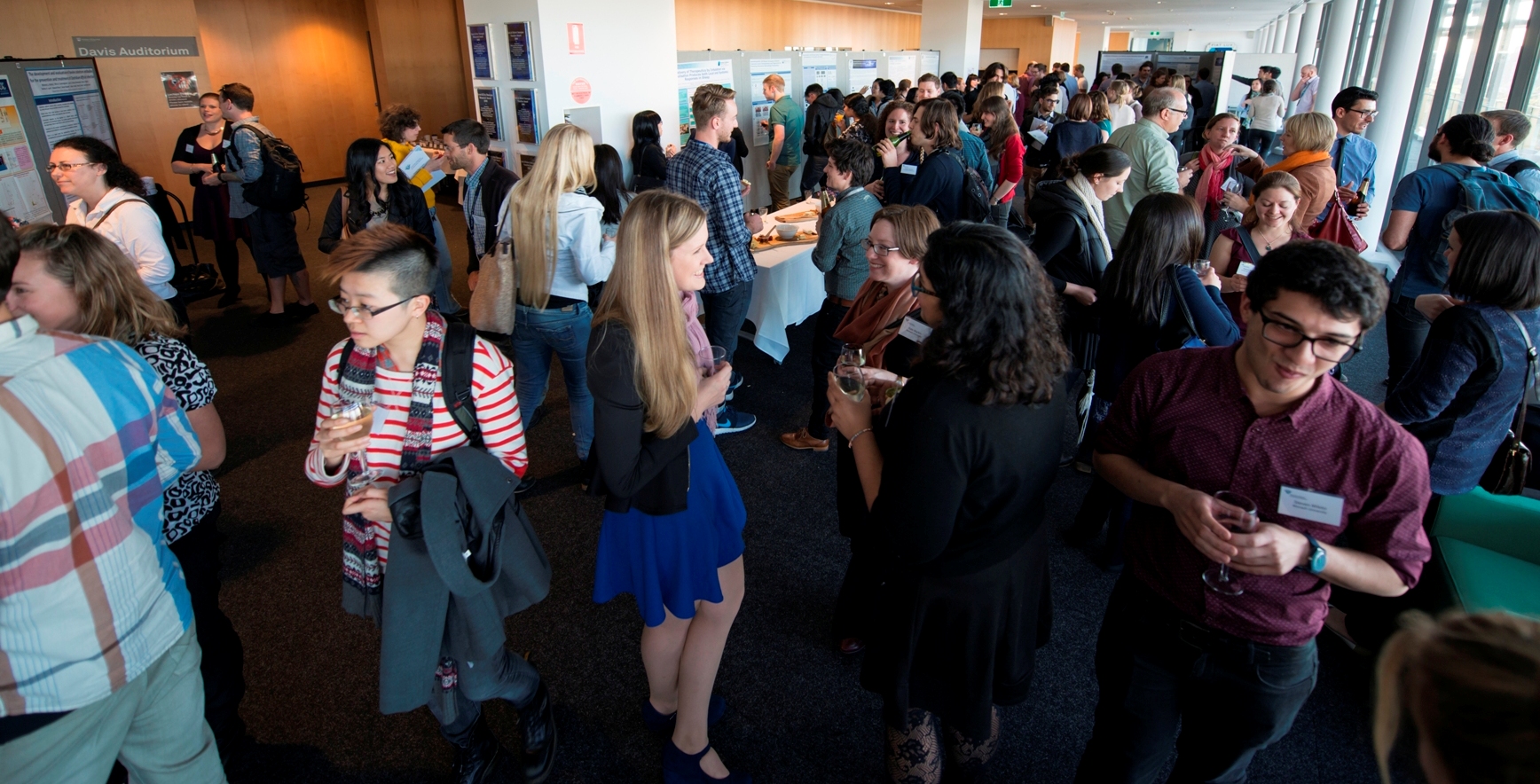| |
POSTER PROGRAM (subject to change)
|
|
|
Macrophage responses to P. falciparum infected erythrocytes with different binding phenotypes
Elizabeth Aitken, University of Melbourne, Department of Medicine (RMH) (PD) |
|
|
Mapping the spatial distribution of Bairnsdale ulcer cases in Victoria
Michael Selorm Avumegah, Deakin University, School of Medicine (PG) |
|
|
Improving molecular detection, identification and serotyping of Streptococcus pneumoniae in complex samples
Laura Boelsen, Murdoch Childrens Research Institute (PG) |
|
|
Dissection of PTEX88, a component of the malaria protein export machinery
Scott Chisholm, Deakin University, School of Medicine (PG) |
|
|
In vitro Biofilm Model of Prosthetic Joint Infections
Darcie Cooper, Deakin University, School of Medicine (PG) |
|
|
A fluorescent tool to probe NK1 receptor signalling from endosomal platforms
Joshua Conner, Monash University, Department of Medicinal Chemistry (PG) |
|
|
The molecular basis of CD4+ T cell priming of CD8+ T cell memory formation
Jolie Cullen, University of Melbourne, Department of Microbiology and Immunology at the Peter Doherty Institute (PG) |
|
|
The molecular determinants of neuroinvasion of henipaviruses in the mouse model
Sarah Edwards, CSIRO Australian Animal Health Laboratory and Monash University, Department of Microbiology (PG) |
|
|
MNV infection and its impact on the host microtubule network
Svenja Fritzlar, University of Melbourne, Department of Microbiology and Immunology at the Peter Doherty Institute (PG) |
|
|
The role of the GcvB sRNA in the regulation of protein production in Pasteurella multocida
Emily Gulliver, Monash University, Department of Microbiology (PG) |
|
|
Population Structure and Genome dynamics of Plasmodium falciparum in Papua New Guinea
G.L. Abby Harrison, Walter and Eliza Hall Institute (PD) |
|
|
Association between binding phenotype of malaria-infected erythrocytes and cytokine secretion
Marzieh Jabbarzare, University of Melbourne, Department of Medicine at the Peter Doherty Institute (PG) |
|
|
TNF-induced pain requires local colony-stimulating factor (CSF)-1 signaling and systemic neutrophil infiltration
Hsu Wei Khiew, University of Melbourne, Department of Medicine (RMH) (PG) |
|
|
Understanding cellular immunity to influenza B viruses
Marios Koustakos, University of Melbourne, Department of Microbiology and Immunology at the Peter Doherty Institute (PG) |
|
|
Linking MIF and IL-1 family cytokines in the pathogenesis of gout and RA
Tali Lang, Monash University, Centre for Inflammatory Diseases (PD) |
|
|
Assessing clonality in malaria parasites from massively parallel sequencing data
Stuart Lee, Walter and Eliza Hall Institute (PG) |
| |
Investigation into the innate antiviral immune system of bats using CRISPR technology
Stacey Leech, CSIRO Australian Animal Health Laboratory (PD) |
|
|
Boosting the immune response after dendritic cell targeted priming
Jessica Li, Burnet Institute (PG) |
|
|
Characterization of inhibitors and monoclonal antibodies that modulate the interaction between P. falciparum adhesin PfRh4 with its erythrocyte receptor Complement Receptor 1
Nicholas Lim, Walter and Eliza Hall Institute (RA) |
|
|
Gene editing in chickens: knockdown of Interleukin-6 using CRISPR technology
Qi Liu, Deakin University, School of Medicine (PG) |
|
|
The role of the nucleus in West Nile virus replication
Adam López-Denman, University of Melbourne, Department of Microbiology and Immunology at the Peter Doherty Institute (PG) |
|
|
Antibody responses to Plasmodium falciparum and P. vivax and prospective risk of Plasmodium infection postpartum
Alistair McLean, Burnet Institute (PG) |
|
|
ECM remodelling by ADAMTS5 enzymes facilitates T cell migration following influenza virus infection
Meagan McMahon, Deakin University, School of Medicine (PG) |
|
|
Comparative genomic analysis of Streptococcus pneumoniae isolates that cause middle ear infections in mouse models
Sam Manna, Murdoch Childrens Research Institute (PD) |
|
|
Type I interferon regulation of the immune response to breast and ovarian cancer
Zoe Marks, Hudson Institute of Medical Research (PG) |
|
|
Inactivation of the RNA-binding chaperone Hfq in Pasteurella multocida results in reduced capsule expression and reduced in vivo fitness
Marianne Mégroz, Monash University, Department of Microbiology (PG) |
|
|
Effects of Helicobacter pylori infection on host iron metabolism
Saad Mohammed, Deakin University, School of Medicine (PG) |
|
|
Innate cellular response to Plasmodium falciparum Erythrocytes Membrane Protein 1 (PfEMP1)
Madi Njie, University of Melbourne, Department of Medicine at the Peter Doherty Institute (PG) |
|
|
Functional antimalarial immunity in regions of emerging artemisinin resistance
Katherine O’Flaherty, Burnet Institute (PG) |
|
|
Antimicrobial therapy that targets selenium metabolism to treat Clostridium difficile infection
Christine Roder, Deakin University, School of Medicine (PG) |
|
|
Nuclear trafficking of the rabies virus interferon antagonist P-Protein is regulated by an importin-binding nuclear localization sequence in the C-terminal domain
Caitlin Rowe, Monash University, Department of Biochemistry and Molecular Biology and University of Melbourne, Department of Biochemistry and Molecular Biology (PG) |
| |
Investigating interleukin-2 receptor family signalling in zebrafish
Robert Sertori, Deakin University, School of Medicine (PG) |
|
|
Distinct roles for IAP family members in innate immune signalling
Che Stafford, Walter and Eliza Hall Institute (PG) |
|
|
Development of high-throughput assays to investigate neurotoxicity in prion and synucleinopathy disease
Cathryn Ugalde, University of Melbourne, Department of Biochemistry and Molecular Biology at Bio21 Institute (PG) |
|
|
Essential role of SPECT1 and SPECT2 in establishing Plasmodium falciparum liver stage malaria
Annie S.P. Yang, Walter and Eliza Hall Institute (PG) |
|
|
Co-utilisation of diverse carbon sources and metabolic robustness of the intracellular parasite Toxoplasma gondii
Jiang-Nan Zhu, University of Melbourne, Department of Biochemistry and Molecular Biology at Bio21 Institute (PG) |






